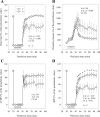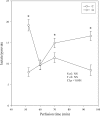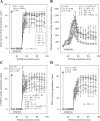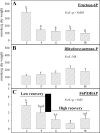An increase in the redox state during reperfusion contributes to the cardioprotective effect of GIK solution
- PMID: 22797310
- PMCID: PMC3472475
- DOI: 10.1152/japplphysiol.01153.2011
An increase in the redox state during reperfusion contributes to the cardioprotective effect of GIK solution
Abstract
This study aimed at determining whether glucose-insulin-potassium (GIK) solutions modify the NADH/NAD(+) ratio during postischemic reperfusion and whether their cardioprotective effect can be attributed to this change in part through reduction of the mitochondrial reactive oxygen species (ROS) production. The hearts of 72 rats were perfused with a buffer containing glucose (5.5 mM) and hexanoate (0.5 mM). They were maintained in normoxia for 30 min and then subjected to low-flow ischemia (0.5% of the preischemic coronary flow for 20 min) followed by reperfusion (45 min). From the beginning of ischemia, the perfusate was subjected to various changes: enrichment with GIK solution, enrichment with lactate (2 mM), enrichment with pyruvate (2 mM), enrichment with pyruvate (2 mM) plus ethanol (2 mM), or no change for the control group. Left ventricular developed pressure, heart rate, coronary flow, and oxygen consumption were monitored throughout. The lactate/pyruvate ratio of the coronary effluent, known to reflect the cytosolic NADH/NAD(+) ratio and the fructose-6-phosphate/dihydroxyacetone-phosphate (F6P/DHAP) ratio of the reperfused myocardium, were evaluated. Mitochondrial ROS production was also estimated. The GIK solution improved the recovery of mechanical function during reperfusion. This was associated with an enhanced cytosolic NADH/NAD(+) ratio and reduced mitochondrial ROS production. The cardioprotection was also observed when the hearts were perfused with fluids known to increase the cytosolic NADH/NAD(+) ratio (lactate, pyruvate plus ethanol) compared with the other fluids (control and pyruvate groups). The hearts with a high mechanical recovery also displayed a low F6P/DHAP ratio, suggesting that an accelerated glycolysis rate may be responsible for increased cytosolic NADH production. In conclusion, the cardioprotection induced by GIK solutions could occur through an increase in the cytosolic NADH/NAD(+) ratio, leading to a decrease in mitochondrial ROS production.
Figures







Similar articles
-
Inhibition of the malate-aspartate shuttle by pre-ischaemic aminooxyacetate loading of the heart induces cardioprotection.Cardiovasc Res. 2010 Nov 1;88(2):257-66. doi: 10.1093/cvr/cvq205. Epub 2010 Jun 18. Cardiovasc Res. 2010. PMID: 20562422
-
[Effects of glucose-insulin-potassium cocktail on cardiac myocyte death and post-ischemic recovery cardiac functional recovery: the critical role of insulin].Zhonghua Nei Ke Za Zhi. 2003 Mar;42(3):148-52. Zhonghua Nei Ke Za Zhi. 2003. PMID: 12816693 Chinese.
-
Metabolic modulation of cellular redox potential can improve cardiac recovery from ischemia-reperfusion injury.Int J Cardiol. 1998 Jul 1;65(2):139-47. doi: 10.1016/s0167-5273(98)00117-x. Int J Cardiol. 1998. PMID: 9706808
-
Insulin therapy as an adjunct to reperfusion after acute coronary ischemia: a proposed direct myocardial cell survival effect independent of metabolic modulation.J Am Coll Cardiol. 2003 Apr 16;41(8):1404-7. doi: 10.1016/s0735-1097(03)00164-5. J Am Coll Cardiol. 2003. PMID: 12706939 Review.
-
Mitochondrial Bioenergetics During Ischemia and Reperfusion.Adv Exp Med Biol. 2017;982:141-167. doi: 10.1007/978-3-319-55330-6_8. Adv Exp Med Biol. 2017. PMID: 28551786 Review.
Cited by
-
Protective approaches against myocardial ischemia reperfusion injury.Exp Ther Med. 2016 Dec;12(6):3823-3829. doi: 10.3892/etm.2016.3877. Epub 2016 Nov 7. Exp Ther Med. 2016. PMID: 28101167 Free PMC article.
-
Glucose-insulin-potassium therapy in patients with acute coronary syndrome: a meta-analysis of randomized controlled trials.BMC Cardiovasc Disord. 2014 Nov 25;14:169. doi: 10.1186/1471-2261-14-169. BMC Cardiovasc Disord. 2014. PMID: 25425404 Free PMC article. Review.
-
A chronic low-dose magnesium L-lactate administration has a beneficial effect on the myocardium and the skeletal muscles.J Physiol Biochem. 2022 May;78(2):501-516. doi: 10.1007/s13105-021-00827-8. Epub 2021 Jul 22. J Physiol Biochem. 2022. PMID: 34292519
-
Novel Flurometric Tool to Assess Mitochondrial Redox State of Isolated Perfused Rat Lungs after Exposure to Hyperoxia.IEEE J Transl Eng Health Med. 2013 Oct 16;1:1500210. doi: 10.1109/JTEHM.2013.2285916. IEEE J Transl Eng Health Med. 2013. PMID: 25379360 Free PMC article.
-
α1A-Adrenergic receptor prevents cardiac ischemic damage through PKCδ/GLUT1/4-mediated glucose uptake.J Recept Signal Transduct Res. 2016;36(3):261-70. doi: 10.3109/10799893.2015.1091475. Epub 2015 Sep 29. J Recept Signal Transduct Res. 2016. PMID: 26832303 Free PMC article.
References
-
- Angelos MG, Murray HN, Gorsline RT, Klawitter PF. Glucose, insulin and potassium (GIK) during reperfusion mediates improved myocardial bioenergetics. Resuscitation 55: 329–336, 2002 - PubMed
-
- Bellows SD, Kloner RA. Glucose-insulin-potassium does not reduce myocardial infarct size in an ischemic/reperfusion rabbit model. J Thromb Thrombolysis 5: 25–27, 1998 - PubMed
-
- Bergmeyer HU. (editor). Methods of Enzymatic Analysis. London: Academic, 1974
Publication types
MeSH terms
Substances
LinkOut - more resources
Full Text Sources

